How Small Businesses Made their Mark with Video in 2020
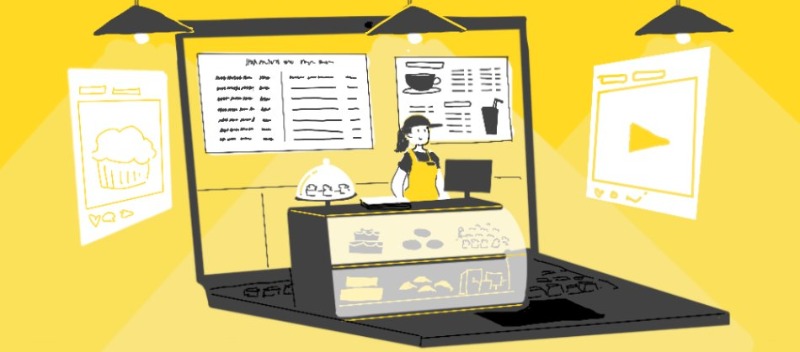

It’s hard to say if change motivates human beings to strive for improvement or if it is their ability to strive
for progress that leads to change. Maybe it’s both. But however you see it, the year 2020 was an episode that
brought a change that was too much for any human being’s liking.
The year witnessed the Covid-19 pandemic that brought the World economy to a halt. As we are navigating through
the last few days of the year, most countries are still reeling from the irreparable damage caused by the
pandemic, with over 1.5 million people losing their lives to the deadly viral infection. And it’s not just the
healthcare infrastructure that was left scrambling. The contagious disease has severely impacted the World economy
itself. According to World Bank forecasts, the global economy will shrink by 5.2% in 2020. It would represent the
deepest recession since the Second World War, with the largest fraction of economies experiencing declines in per
capita output since 1870.
One of the business segments that have been severely impacted during this period is small businesses. According to
Alignable’s Road to Recovery report, 42% of small and medium businesses (SMBs) are unlikely
to make it to 2021. Adding to that, the year-on-year spending on arts and entertainment has gone down 74% compared
to 2019, while the restaurant business is witnessing a 50% drop in revenue from last year. Both of these are good
representatives of local SMBs in the US.
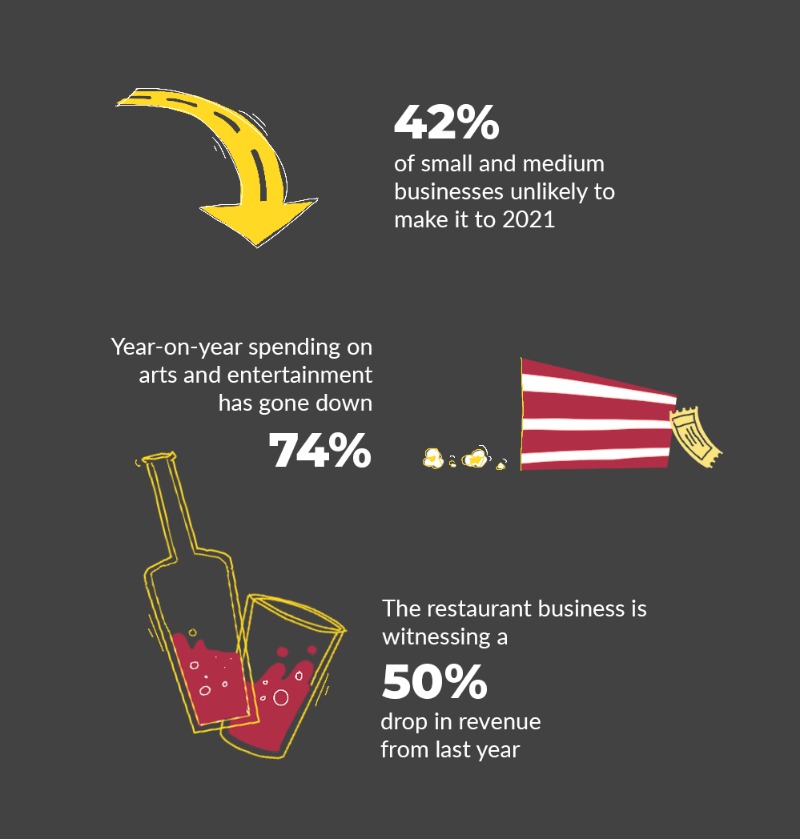
Impact 2020 had on small businesses
But the story of SMBs during Covid-19 won’t be complete without talking about the grit and resilience shown by
many small businesses in the face of the pandemic-led economic slowdown.
In a survey by Society for Human Resource Management (SHRM), 43% of the small businesses found
innovative and scrappy ways to stay in business. To adapt to the adverse market conditions, small businesses
reported making changes in the way they provide value to customers.
For example, some of them adopted contactless deliveries to make their services available, whereas others
requested employees to learn new skills to support business models. Many businesses have adopted online video to
create paid video courses and Livestream experiences off their trade, while others have started adopting
video-based digital workspaces to collaborate with their employees, saving on real estate rentals.
An encouraging story that elucidates the grit shown by the small businesses is Moriarty’s Gem Art, a family-owned
jewelry business located in Crown Point, Indiana. When they had to close their shop in March, they knew they had
to come up with something different and started contemplating the option of doing paid live-streams. Doing a
live-streamed show had been on the to-do list for the business last year, but they did not have time to produce a
show while running the retail outlet, founded in 1975. Covid-19 changed that.
"About two weeks into the crisis, we started doing live streams through YouTube using YouTube Studio software,"
Jeff Moriarty, marketing manager and oldest son of co-owners Steve and Nancy Moriarty. Moriarty Gem Art realized
$12,000 in revenue from its July 8 show. During the pandemic, another show resulted in a $20,000 sale of a
Tanzanite stone to a customer in Singapore who attended the live-stream. And the stories of such businesses are
many. 32% of small businesses have identified a new way to deliver existing services.
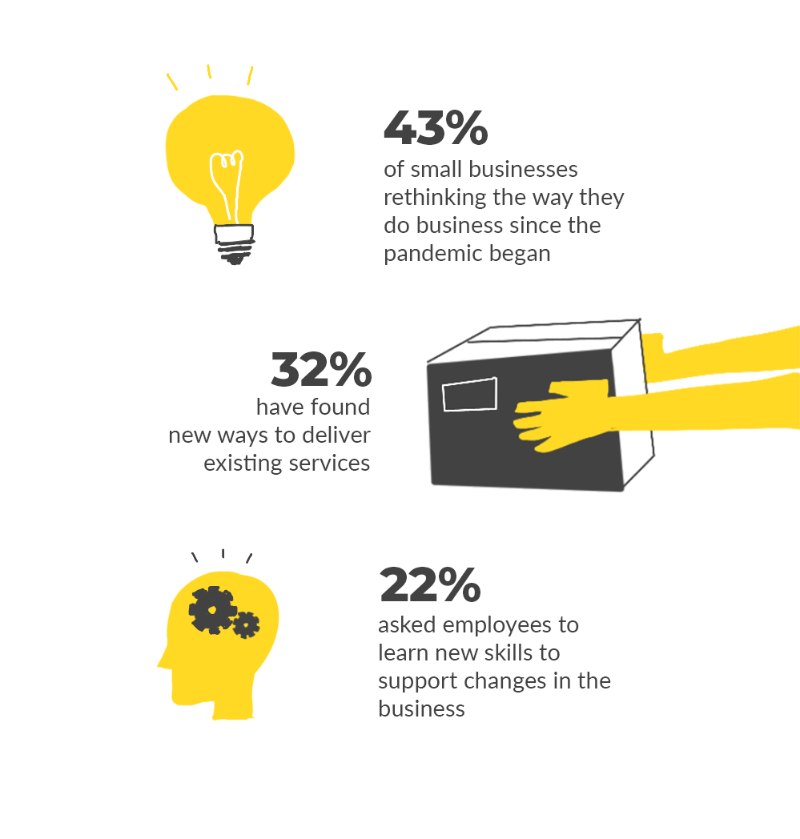
Promising numbers around small businesses re-inventing themselves.
Let’s now try to learn how small businesses are adapting to the new circumstances thrown at them due to the
pandemic.
While anecdotes of success serve our need for inspiration, it is essential to understand how these small
businesses have innovated in 2020. And it’s a story of digital transformation and adoption for most businesses.
SMBs that had a hyper-local nature to their business realized that creating non-hyper-local value has the
potential to attract a new customer base from far and wide. And that is precisely what Moriarty’s Gem Art
understood well. Sharing their knowledge about gems and cut stones with a global audience through video-streams on
YouTube, the business gained the potential to acquire customers from anywhere in the world. Provided there’s a way
for them to provide value in terms of goods and services to the customer may be living thousands of miles away.
Today this is not a problem thanks to the logistics and internet infrastructure that covers most of the world. So
the first change is this: The World is your audience now, thanks to the Internet.
With businesses going online, the conventional channels of communicating with your customers change. You now start
thinking where these customer personas of yours hang out- not in your town, but on the internet. If you were a
hairstylist, you would probably meet most of your audience on Pinterest, where people around the world come to
check out hairstyle inspirations in the form of pins. If you are a Yoga teacher who used to run a studio, you are
likely to consider publishing a Yoga course on a learning platform like Teachable or start your own YouTube
channel. This shift in thinking about your customers is the second change: You identify online channels to
reach your target audience.
The third transformation that most SMBs have witnessed is the way they interact with their audience. If it was a
personal walk-through in their 500 square feet store that helped close a sale, they now understand that it’s not
possible to do the same online. They’ve identified that they need to adopt media like online video to interact
with their customers worldwide to ensure the same level of authenticity and engagement in their conversations. It
could be a webinar on Zoom or a how-to video on YouTube - they all help bridge the gap of physical connectivity in
the online world. It’s not surprising to learn that most fitness studios are building their video-first online
presence, and existing websites and apps have seen growth upward of 100% in a few months during the pandemic. So
the third change that SMBs are embracing: Use video to connect with your audience.
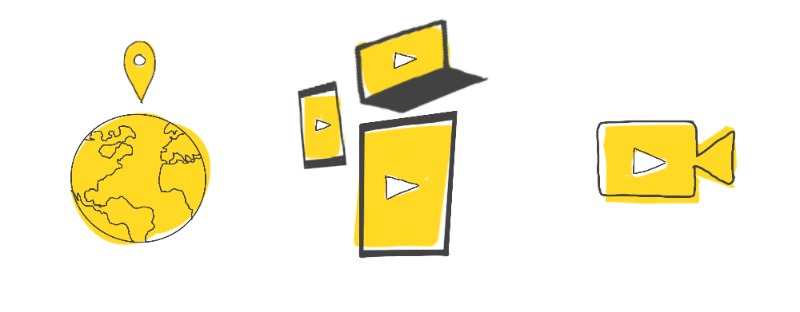
Changes for SMBs in terms of digital transformation and adoption.
We will now delve deeper into how small businesses are adopting online video to reach their audience. And to do
that, we will cover the story of 5 video entrepreneurs who innovated with video during the pandemic.
So far, we’ve talked about the innovative potential for SMBs’ business processes in 2020. But you’re probably still wondering what really makes video such a catalyst in this significant change? Let’s look at five small businesses and organizations that have fought against the harsh circumstances, re-imagined their business with videos, and are doing well today. Their inspiring stories illustrate how they have used video design and marketing to run an efficient business.

Virtual events are growing in popularity as a creative marketing strategy for many small businesses. But for
nonprofit organizations, virtual events solve a slightly different problem. To understand this better, we spoke to
the BTB Foundation, who are exploring virtual events
to adapt to the new normal.
Since 2002 Tom and Bill Latourette have been organizing an annual charity Golf Event to raise funds for local
families battling cancer and several cancer-related charities. One of the biggest challenges the pandemic brought
about was an abrupt halt to this most enjoyed fundraising event.

For non-profits like the BTB Foundation, events are a vital part of coming together as a community to share
information, awareness, and support for causes. In the past, their event would raise $140K, but with the
challenges brought about by the pandemic, they now needed to explore a way to substitute some of that income and
stay committed to their mission of helping 17 families this year.
Since they could no longer host in-person events, they decided to host their annual Golf Event virtually. With
videos created on Typito, they were able to launch a virtual program event to help generate involvement,
sponsorships, and interest, just as they do every year.
With such success using video, they’re convinced about expanding video to amplify their reach and impact in the
year ahead.

Amazon Watch is a nonprofit organization founded in
1996 to protect the rainforest and advance the rights of Indigenous Peoples in the Amazon Basin. Storytelling has
been a central part of their awareness campaigns to rile up sentiments about the current issues affecting the
Amazon rainforest and Indigenous peoples and provoke action.
Although research is incredibly important to what they do, especially for advocating financial policy change, not
many people read 60-page reports on such topics. They’ve been tapping into the visual and creative potential of
video to bring out such stories from the deep Amazon Basin and share them with people all over the world via
social media platforms. This has allowed them to bridge the gap between data and the stories that affect people
and move people to action.

Covid-19 has hit the Amazon very hard, and to cope, the organization needed to find a way to continue supporting
Indigenous Partners through this pandemic. The Indigenous populations in the Amazon are underserved by the
governments and have existing significant barriers to culturally-appropriate and adequate healthcare. But Amazon
Watch has taken on the challenge to get required resources from their partners, including health concentrators for
remote health posts so that they’re able to stay updated, safe, and healthy.
Non-profit organizations like Amazon Watch often operate with little resources and employees taking on multiple
roles to fill skill gaps. There is a pressing need to make videos quickly when telling time-sensitive stories and
this is where online video editing tools can speed up the video creation process without demanding a high learning
curve.

With people and businesses forced to be confined at home, video conferencing apps became a central part of daily
routines. While businesses worldwide began to transition to an “online-way of doing things”, it became evident
that the transformation could get a bit challenging for small companies with a limited budget for resources. This
is perhaps where tools like Zoom could fit in perfectly with its flexibility and affordability to manage business
operations online.
One of Illinois’ largest trade associations, Illinois
REALTORS® is yet another organization that is working to find creative ways to tackle the inability to have
in-person events and a sudden increase in the need for visual communication. They began to collect video footage
from Zoom call recordings and used Typito to stitch those videos together with transitions, music, and captions to
make a complete video story.

Videos let them put a human face on their messages and create a stronger connection than just an email or a blog
post. Moreover, they were able to tell a story effectively and in a short amount of time with a sense of autonomy
in the way they wanted to tell their story free from restrictive video templates that are inflexible and create
cookie-cutter videos that compromise the creative individuality of any video they create.
In the last 20 years, Illinois REEF has awarded scholarships totaling over $803,000! Help others further their education...
Posted by Illinois Realtors on Tuesday, 1 December 2020

Telling impactful stories about brands can go a long way to move viewers and build authentic relationships. The
best way to create authenticity for brand stories with video often requires capturing onsite business action. With
COVID-19 restrictions in place, it made it challenging to be onsite to film videos. To ensure that brands stay
connected with audiences and stay relevant during these times of change, Hearst Bay Area wanted to use videos to
showcase brands and missions during these challenging times.
It sure is getting cold outside! Thankfully our Hodgepodge store in San Rafael is still open for business. Our staff is...
Posted by Hospice by the Bay on Wednesday, 16 December 2020
In the wake of such challenges, Hearst Bay Area decided to shift the narrative of stories to leverage
client-produced content. Equipped with an intuitive video editing tool like Typito, they could easily edit video
lengths and splice videos together, edit in titles and graphics to match branding, and - voila! Creative
storytelling revived.

This small change in the way Hearst Bay Area began to create videos had a significant impact. It increased impressions and engagement on social media platforms. The ability to edit videos easily allowed them to repurpose client-filmed content, even when they couldn't be onsite to direct the filming of the content in the first place. On the plus side, clients too loved seeing their employees featured in their content.

Catalystas Consulting is a team of experts
committed to helping companies who want to grow, change, or develop new ways. Before the pandemic, the team was
able to conduct research and training in face-to-face settings. With COVID-19 restrictions in place, they have had
to find new ways to engage with clients and partners virtually to maintain a competitive, innovative, and
compelling edge.
Hi, it’s Aviva, your friendly neighborhood Catalysta, and I want to talk about skirtism. ❓The What: It’s when a woman...
Posted by Catalystas Consulting on Tuesday, 13 October 2020
Creating videos has allowed them to provide remote training courses that consist of an entire online training
module for a client that can be reused and referred to for future iterations, rather than repeating an in-person
course multiple times. This has also helped them improve their social media and marketing strategies for greater
reach and remote access.

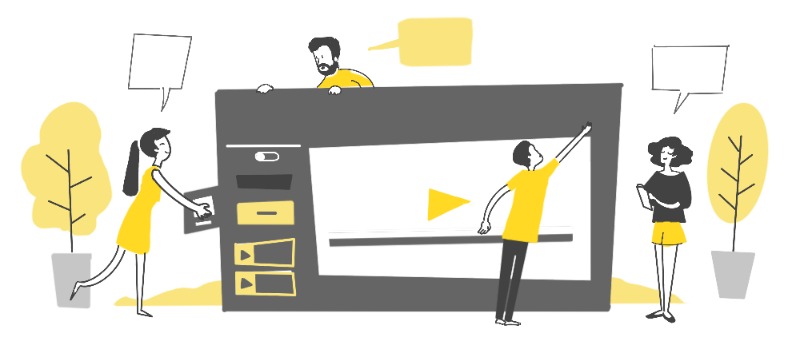
Apart from true grit, there was a lot we were able to learn from these small businesses’ stories. We’ve seen how
these businesses, organizations, and nonprofits could leverage video and change their approach to marketing
strategies. Perhaps it was the deep flexibility that video can offer as a channel, medium, and format - one that
allows the next closest alternative to personal virtual interactions that are so essential for business functions.
Or perhaps it was more than video at play. Our learnings weren't just limited to video. We were able to understand
how video was a facilitator to these creative marketing strategies. Here are three strategies we were able to
outline from the stories.
Small businesses and Non-Profits tend to be networked within a smaller local market and rely so much on in-person
interactions and personal connections, whether building brand affinity or rallying up sentiments for a cause. Just
when we thought COVID-19 restrictions brought all of this interaction to a standstill, businesses improvised with
alternatives - virtual interactions.
Moving interactions online was a necessary and sustainable alternative to months of planning and arrangements made
for events, conferences, and meets. With a growing marketplace for tools, this shift was easy. Virtual events gave
businesses, organizations, and nonprofits a promising alternative to creating worthwhile and memorable
interactions. While it may have started as an alternative, it’s no longer a ‘compromise’ or a ‘next best thing’ to
in-person events but has managed to carve out its spot online for all the right reasons.
Apart from being convenient, virtual interactions through online events and meets transcend geographical barriers
to allow more people to participate irrespective of the country or continent they’re in. This gives you a better
chance at networking, an opportunity to build better leads, and stimulate more curiosity about what you do.
While local networks may hold sustenance, expanded global networks have the potential to fresher and expansive
markets.
Confronted by shrinking finances and dwindling sales, brands are forced to rethink priorities and reevaluate how
to best reach out and reconnect with customers. Creating content that is refreshing in a difficult time when we’re
forced to just cope and live in isn't easy. The marketing messaging approach in a pre-covid world might no longer
be relevant and would need deep thinking to be contextualized. Here is where small businesses were really able to
reinvent new combinations of content with their most trusted allies - their customers.
Brands and organizations can decrease the gap between stagnating content creation during the pandemic and the
ever-increasing demand for content by leveraging user-generated content. User-generated content allows businesses
to communicate with audiences more directly, transparently, and candidly. Apart from this, it will enable small
businesses to better deal with reduced marketing budgets and build real connections with their customers on social
media with an overwhelming sense of shared empathy and support.
Another way to leverage the power of your customers is to harness your social media presence. Small businesses who
have had to scrap store-fronts can find new ways to sell their products with e-commerce platforms like Shopify. In
response to the surge of e-commerce, Facebook also announced Facebook Shops as a seamless way for small businesses to build online stores on
Facebook and Instagram and leverage an existing online presence.
If it’s anything we shared during this pandemic, it’s a sense of empathy that we’re all in this together on either
side of the business - customers and employees alike. The people who make up your team are one of your important
assets. In fact, their well-being is equally important as your customers. Once it’s finally time when businesses
can resume operations as usual (even it means a ‘newfound usual’), the steps you take now to ensure your team’s
well-being will go a long way to reinforce what you stand for as a business.
There are several ways to help your team grow, and most of this effort won't come at a big-budget and can be as
simple as creating a flexible and supportive work environment or providing them with the right tools for seamless
workflows.
Rethink ways in which you can help your team develop a growth mindset to learn new skills to help them grow. In
her book, Mindset: Changing The Way You Think To Fulfil Your Potential, Carol Dweck shares how a simple
shift to a growth mindset can create a love of learning and a resilience that can eventually become the basis of
great accomplishments and fulfillment, regardless of the outcome. Encouraging your team to adopt a growth mindset
could set the stage for your business growth and wellbeing in the long run.
Often, teams find themselves taking over additional roles, especially when working with members' reduced capacity.
Deliver better tools and technology to your teams for facilitating business operations online, whether it's tools
for video conferencing team meets or just better-suited task management tools for remote working. Find tools that
are efficient and easy to use. This way, employees can dedicate more time to doing tasks creatively and uniquely
instead of spending time to learn how to use a tool.
Many Small Businesses have managed to stay resilient against all odds and adapted to the new normal. Behind all
these resilient small-business is a powerful and inspiring story about how they could adapt to challenges,
struggles, and setbacks. As business eventually resumes at a more encouraging pace, innovations that were
considered short-term adaptive strategies could be here for the long haul.







